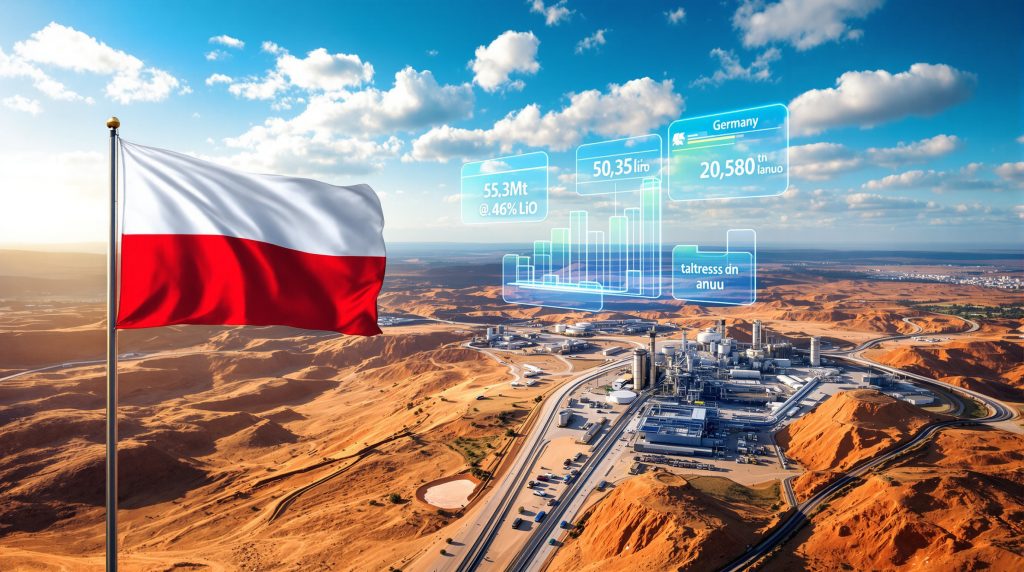Strategic Market Dynamics Shape European Lithium Supply Independence
The global transition toward electric mobility has fundamentally altered the strategic calculus surrounding battery materials, with lithium emerging as a cornerstone element for European industrial sovereignty. As automotive manufacturers across the continent accelerate electrification timelines, the imperative for domestic lithium production capabilities has evolved from economic preference to geopolitical necessity. This transformation reflects broader supply chain resilience strategies, where proximity to end-use manufacturing provides both cost advantages and strategic security. Furthermore, the critical minerals energy transition continues to reshape global resource allocation priorities.
European policy frameworks increasingly prioritise critical materials independence, with lithium positioned at the centre of these initiatives. The European Green Deal's ambitious carbon neutrality targets by 2050 require unprecedented battery production capacity, creating structural demand that far exceeds current domestic supply capabilities. Within this context, hard rock lithium deposits present unique advantages over traditional brine operations, offering faster production timelines and greater output predictability essential for meeting accelerated deployment schedules.
What Makes the Cinovec Lithium Project a Strategic European Asset?
The European Metals lithium project represents a convergence of geological advantage, strategic location, and policy alignment that positions it uniquely within Europe's critical materials landscape. Located in the Czech Republic's Krušné hory Mountains, this hard rock deposit contains 708.2 million tonnes of lithium resources across measured, indicated, and inferred categories, establishing it as Europe's largest documented lithium resource outside of traditional brine operations.
Resource specifications demonstrate exceptional scale:
-
Measured Mineral Resource: 53.3 million tonnes at 0.48% Li2O
-
Indicated Mineral Resource: 360.2 million tonnes at 0.44% Li2O
-
Inferred Mineral Resource: 294.7 million tonnes at 0.39% Li2O
-
Combined lithium carbonate equivalent: 7.39 million tonnes
The project's geographic positioning within 100 kilometres of Prague provides direct access to Central European transport networks, while proximity to German automotive manufacturing clusters creates natural supply chain integration opportunities. This location advantage becomes particularly significant when considering the logistics costs associated with importing lithium from Australian lithium innovations or South American brine facilities.
Geological Characteristics and Resource Quality
Cinovec's lithium mineralisation occurs within pegmatitic formations that typically yield higher-grade concentrations compared to many global hard rock deposits. The resource's 0.39-0.48% Li2O grade range positions it favourably against industry benchmarks, where economically viable hard rock operations typically require minimum grades of 0.5-0.6% Li2O for competitive cost structures.
The deposit's geological continuity and structural predictability enable conventional mining methodologies, reducing technical risk compared to more complex ore body geometries. Additionally, the presence of tin and potash as byproduct credits enhances project economics through diversified revenue streams, a factor that distinguishes Cinovec from lithium-only operations globally.
Infrastructure and Operational Advantages
Existing infrastructure development around the Cinovec site includes established road and rail connections within 10 kilometres, reducing the capital intensity typically associated with greenfield mining projects in remote locations. The availability of skilled mining workforce from the region's industrial heritage provides human capital advantages often overlooked in project economic assessments.
Power generation capacity within the broader Czech energy grid, combined with the country's renewable energy development initiatives, positions the project for lower carbon intensity production compared to coal-dependent mining operations in other jurisdictions.
How Does Government Funding Transform Project Economics?
The Czech government's €360 million grant commitment through the Strategic Investments for a Climate-Neutral Economy program fundamentally alters the risk-return profile for the Cinovec project development. This non-dilutive funding, equivalent to approximately AU$645 million, represents one of the largest direct government commitments to a critical raw materials project within European Union jurisdiction.
Funding structure provides multiple strategic advantages:
| Funding Component | Amount | Source | Structure |
|---|---|---|---|
| Czech Government Grant | €360 million | Climate-Neutral Economy Program | 35% capex reimbursement |
| EU Just Transition Fund | €36 million | European Commission | Direct allocation |
| Total Government Support | €396 million | Combined Programs | Non-dilutive capital |
The reimbursement mechanism covering 35% of eligible capital expenditures effectively reduces project financing requirements while maintaining European Metals' operational control through its 49% ownership stake in the Geomet joint venture. This structure contrasts sharply with traditional project finance arrangements where debt service obligations can constrain operational flexibility during volatile commodity price cycles.
Risk Mitigation Through Public-Private Partnership
The partnership with ČEZ Group, where the Czech government maintains 70% ownership, creates a unique risk-sharing framework that combines private sector operational efficiency with public sector strategic objectives. This arrangement ensures continued funding support through project development phases while providing European Metals shareholders with leveraged exposure to the European Metals lithium project.
European Metals Holdings' market capitalisation of approximately AU$104 million provides investors with exposure to a project backed by over AU$700 million in government commitments, creating asymmetric risk-reward dynamics rarely available in purely private mining developments. This funding security removes traditional development-stage risks associated with securing adequate capital for construction and commissioning phases.
Financial Impact and Shareholder Value Creation
The 139% share price increase following the grant announcement reflects market recognition of the transformational impact on project economics. From a trading price of 23 cents to 46 cents, the market response demonstrates investor appreciation for reduced execution risk and enhanced project viability.
The Czech government's award of a grant of up to 360 million euros represents one of the largest direct project level funding commitments to a critical raw materials project within the European Union.
This government backing effectively provides a form of political risk insurance, ensuring project continuity despite potential changes in commodity pricing or global economic conditions. For shareholders, this represents a fundamental shift from speculative mining investment to a government-backed strategic asset development.
What Are the Competitive Positioning Factors in Global Lithium Markets?
Cinovec's competitive positioning extends beyond resource scale to encompass cost structure advantages, location premiums, and supply chain integration potential that distinguish it within the global lithium production landscape. The project targets 29,386 tonnes per annum of battery-grade lithium hydroxide, representing approximately 8% of projected European Union lithium demand by 2030. However, the broader context of lithium market challenges must be considered when evaluating competitive dynamics.
Market positioning analysis reveals multiple competitive advantages:
| Competitive Factor | Cinovec Advantage | Global Benchmark | Strategic Impact |
|---|---|---|---|
| Production Cost Target | Bottom quartile positioning | Competitive with Australian hard rock | Enhanced margin resilience |
| Location Premium | Direct EU market access | Eliminates trans-Pacific shipping | 15-20% logistics cost reduction |
| Resource Quality | 0.44-0.48% Li2O grades | Above-average hard rock grades | Lower processing costs |
| Byproduct Revenue | Tin and potash credits | Limited in pure lithium operations | Additional revenue streams |
Cost Structure and Operational Economics
Hard rock lithium processing typically requires crushing, flotation, roasting, and chemical leaching to produce battery-grade hydroxide, with processing costs generally higher than brine-based operations but offset by faster production timelines and greater resource predictability. Cinovec's processing methodology targets 8-10 months from ore extraction to battery-grade product, compared to 6-24 months for brine evaporation operations.
The project's target positioning in the bottom quartile of global production costs reflects several operational advantages: established infrastructure reducing capital intensity, favourable geology minimising mining complexity, and proximity to end-use markets reducing logistics expenses. These factors combine to create sustainable competitive positioning even during periods of lithium price volatility.
Supply Chain Integration and Location Premium
European battery manufacturing capacity continues expanding rapidly, with major installations planned or operational within 500 kilometres of the Cinovec site. This proximity facilitates vertical integration opportunities with automotive manufacturers and battery producers seeking supply chain security and reduced inventory carrying costs.
The location advantage becomes particularly significant when considering the alternative supply sources: Australian hard rock operations require approximately 12,000+ kilometre shipping routes to European markets, while Argentinian lithium insights reveal complex logistics through multiple jurisdictions. Cinovec's European location eliminates these transport complexities while providing superior supply chain visibility.
Technology and Processing Innovation
The planned relocation to the Prunérov processing site leverages existing industrial infrastructure while optimising waste management and utility access. This strategic site selection reduces construction costs and timeline while enhancing environmental compliance through utilisation of established industrial zones.
Processing technology deployment focuses on conventional methods proven in other hard rock lithium operations, reducing technical risk while maintaining cost competitiveness. The integration of byproduct recovery systems for tin and potash provides additional revenue diversification beyond primary lithium production.
How Do Development Timelines Align with European EV Demand Growth?
The synchronisation between Cinovec's production timeline and European electric vehicle demand acceleration creates strategic positioning for capturing peak market growth phases. With planned production commencement in 2026, the European Metals lithium project timeline aligns with projected European lithium demand growth that industry analysts forecast at 18x current consumption levels by 2030.
Development milestone coordination:
-
2025: Definitive feasibility study completion
-
2026: Mining operations commencement
-
2027-2030: Production ramp-up phase
-
2030-2050: Full operational capacity through 25-year mine life
This timeline positioning enables the project to capture European lithium market growth during the critical acceleration phase of automotive electrification, when domestic supply sources become increasingly valuable for strategic autonomy and supply chain resilience.
European Demand Projections and Supply Gap Analysis
European lithium consumption forecasts indicate structural supply deficits through 2035, driven by automotive electrification mandates, battery gigafactory expansion, and energy storage deployment. The European Green Deal's carbon neutrality targets by 2050 require unprecedented lithium consumption growth, with domestic production essential for strategic independence.
Cinovec's 29,386 tonne annual output addresses approximately 8% of projected 2030 demand, with expansion potential as additional resource areas within the broader deposit receive development attention. This production level provides meaningful supply contribution while maintaining growth optionality through resource base expansion.
Market Entry Strategy and Timing Advantages
The 2026 production commencement timeline positions Cinovec ahead of most competing European lithium projects, many of which remain in early exploration or permitting phases. This first-mover advantage in European domestic production creates opportunities for premium pricing arrangements with battery manufacturers prioritising supply chain security.
Early production capability also enables capture of potential policy-driven preferences for European-sourced materials, as regulatory frameworks increasingly favour domestic supply chains for strategic materials. The European Metals' strategic funding initiative provides formal recognition supporting preferential treatment in supply chain decisions.
What Investment Risks and Opportunities Exist for EMH Shareholders?
European Metals Holdings' 49% ownership in the Geomet joint venture creates leveraged exposure to European lithium market dynamics while government partnership mitigates traditional development risks. The investment profile combines growth potential from lithium market expansion with risk reduction through unprecedented government backing.
Upside Opportunity Assessment
Market-driven value creation scenarios include:
-
Premium pricing for European-sourced lithium: Supply chain security concerns may drive pricing premiums for domestic production
-
Resource expansion potential: Additional drilling within the broader Cinovec deposit area could expand reserve base
-
Strategic acquisition interest: European battery manufacturers may seek vertical integration through equity participation
-
Policy-driven advantages: Additional EU funding mechanisms for critical materials infrastructure development
The 218% share price appreciation over the past twelve months reflects growing market recognition of these opportunity factors, with the recent grant announcement serving as a catalyst for institutional investor attention to European critical materials investments.
Risk Factors and Mitigation Strategies
Primary risk considerations encompass:
-
Lithium price volatility: Commodity price cycles could impact project economics despite cost advantages
-
Permitting and environmental approval timelines: Regulatory processes may extend development schedules
-
Construction cost inflation: European construction markets experiencing cost pressures
-
Competitive pressure: Alternative European lithium projects may emerge with competing cost structures
However, the government partnership structure provides natural hedging against several of these risks. The €360 million grant commitment reduces financing risk, while ČEZ Group's participation provides regulatory and political risk mitigation through state ownership. Moreover, mining sustainability trends increasingly favour projects with strong environmental and social governance frameworks.
Valuation Framework and Investment Thesis
Current market capitalisation of AU$104 million provides exposure to a project with total government backing exceeding AU$700 million, creating unusual risk-adjusted return potential. This valuation gap reflects both the small-cap nature of European Metals and limited institutional awareness of European critical materials investment opportunities.
The investment thesis centres on European strategic autonomy requirements driving sustained demand for domestic lithium production, combined with Cinovec's unique position as the continent's largest hard rock lithium resource with government backing. This combination creates defensive characteristics unusual in junior mining investments while maintaining growth exposure to accelerating electrification trends.
How Does Cinovec Fit Within European Critical Materials Strategy?
The project's designation as a Strategic Project under the European Union's Critical Raw Materials Act reflects its integral role in broader European policy objectives for supply chain independence and strategic autonomy in battery materials. This recognition provides regulatory advantages and priority access to funding mechanisms while ensuring policy support through development phases.
Policy Alignment and Strategic Importance
European Union critical materials strategy prioritises domestic production capacity for materials essential to the Green Deal transition, with lithium identified as among the most strategically important elements. The Critical Raw Materials Act establishes frameworks for accelerated permitting, financial support, and regulatory certainty for qualified projects.
Cinovec's Strategic Project status provides several operational advantages:
-
Streamlined permitting processes reducing regulatory timeline uncertainty
-
Priority access to EU funding mechanisms beyond the initial grant commitments
-
Reduced regulatory compliance burden through coordinated approval processes
-
Political risk mitigation through formal strategic importance recognition
Geopolitical Implications and Supply Security
European lithium production reduces dependence on Chinese processing capabilities and South American brine operations, both subject to geopolitical risks and supply chain vulnerabilities. China currently controls approximately 60% of global lithium processing capacity, creating strategic dependencies that European policy seeks to address through domestic production capabilities.
The Russia-Ukraine conflict has accelerated European focus on strategic material independence, with critical materials receiving similar priority attention as energy security. The European Metals lithium project development supports these objectives while providing economic benefits through domestic value creation and employment generation.
Integration with Broader EU Energy Transition
Lithium production at Cinovec supports multiple European Green Deal objectives beyond automotive electrification, including energy storage deployment for renewable energy integration and industrial battery applications. The 25-year operational timeline provides long-term supply security for European battery manufacturing investments.
The project's environmental compliance framework aligns with EU sustainability requirements, including carbon footprint minimisation through renewable energy utilisation and waste management best practices. This alignment ensures continued policy support while meeting investor ESG requirements.
What Are the Technical and Operational Advantages of the Prunérov Processing Site?
The strategic decision to relocate processing facilities to the former Prunérov 1 Power Station site optimises construction economics and operational efficiency through existing industrial infrastructure utilisation. This site selection provides multiple technical advantages while reducing capital requirements and construction timelines.
Infrastructure and Utility Advantages
The Prunérov site offers established industrial infrastructure including:
-
Power transmission capacity: Existing electrical infrastructure reducing connection costs
-
Water supply systems: Industrial-scale water treatment and supply capabilities
-
Transport connectivity: Rail and road access optimised for industrial operations
-
Waste management facilities: Established systems for industrial waste processing
-
Skilled workforce availability: Regional expertise in industrial operations and maintenance
These infrastructure advantages reduce project capital intensity while accelerating construction timelines compared to greenfield processing facility development. The site's previous power generation use ensures geological suitability for heavy industrial operations and equipment installation.
Processing Technology and Operational Efficiency
Lithium hydroxide production from hard rock sources requires specialised chemical processing equipment capable of handling corrosive materials and high-temperature operations. The Prunérov site's industrial heritage provides suitable foundations and utility infrastructure for these demanding processing requirements.
Processing sequence optimisation includes:
-
Ore crushing and flotation for mineral concentration
-
Roasting operations for chemical liberation
-
Acid leaching for lithium extraction
-
Purification and precipitation for battery-grade hydroxide production
-
Byproduct recovery for tin and potash revenue streams
The integrated approach maximises resource utilisation while minimising waste generation, supporting environmental compliance and operational cost optimisation.
Environmental and Sustainability Considerations
Processing site selection at Prunérov supports sustainability objectives through brownfield development rather than greenfield environmental impact. The site's industrial designation reduces permitting complexity while enabling environmental remediation through productive redevelopment.
Planned integration with renewable energy sources aligns with Czech Republic's energy transition objectives while reducing operational carbon intensity. The project targets electric mining fleet deployment and local supply chain maximisation to minimise transportation-related emissions.
Waste management optimisation through existing industrial infrastructure provides cost advantages while ensuring environmental compliance with European Union standards. This approach demonstrates responsible resource development supporting long-term operational sustainability.
Frequently Asked Questions About European Metals' Lithium Project
When will Cinovec begin commercial lithium production?
Commercial production is planned to commence in 2026, following completion of the definitive feasibility study and environmental permitting processes. The timeline reflects accelerated development supported by government funding and Strategic Project designation under EU Critical Raw Materials Act.
What makes Cinovec different from other global lithium developments?
Cinovec represents Europe's largest hard rock lithium resource with unprecedented government backing through €360 million in grant funding. The combination of strategic EU designation, government partnership through ČEZ Group, and direct access to European battery manufacturers creates unique competitive positioning.
How does the government partnership structure affect shareholder returns?
While European Metals owns 49% versus 100% of a fully private project, the government partnership provides funding security, reduced development risk, and strategic policy support that may enhance overall returns. The €396 million government backing significantly exceeds European Metals' market capitalisation, creating asymmetric risk-reward dynamics.
What is the projected annual lithium production capacity?
The project targets 29,386 tonnes per annum of battery-grade lithium hydroxide, representing approximately 8% of projected EU lithium demand by 2030. Production capacity includes potential for expansion as additional resource areas receive development attention.
How does Cinovec's location provide competitive advantages?
Located within 500 kilometres of major European battery manufacturers, Cinovec eliminates the 12,000+ kilometre shipping requirements of Australian production while providing superior supply chain visibility and reduced logistics costs compared to South American brine operations.
What are the main investment risks for European Metals shareholders?
Primary risks include lithium price volatility, permitting timeline uncertainty, and construction cost inflation. However, government backing through grant funding and ČEZ Group partnership mitigates traditional development risks while providing political and regulatory support.
How does the EU Critical Raw Materials Act designation benefit the project?
Strategic Project status provides streamlined permitting, priority access to EU funding, and regulatory certainty supporting accelerated development timelines. This designation reflects formal recognition of strategic importance to European electromobility objectives.
What role do byproduct revenues play in project economics?
Tin and potash byproduct recovery enhances project economics through diversified revenue streams beyond lithium production. These credits reduce net lithium production costs while providing additional supply resilience for secondary critical materials.
Disclaimer: This analysis contains forward-looking statements and projections based on current market conditions and government policy frameworks. Lithium market volatility, regulatory changes, and project execution risks may impact actual outcomes. Investment decisions should consider comprehensive due diligence and professional financial advice. Government funding commitments and timeline projections remain subject to formal agreement completion and regulatory approval processes.
Ready to Capitalise on Europe's Next Major Lithium Development?
Discovery Alert's proprietary Discovery IQ model delivers real-time notifications on significant ASX mineral discoveries, transforming complex exploration data into actionable insights for both short-term traders and strategic investors. See how major mineral discoveries can generate substantial market returns by exploring Discovery Alert's dedicated discoveries page, then begin your 30-day free trial to position yourself ahead of the market.




